
Fast Phonics is an online systematic, synthetic phonics program designed for emergent and early readers, as well as older students with gaps in their core reading knowledge.
The Fast Phonics program teaches core phonics skills, including letter–sound correspondence, segmenting and blending, syllable manipulation, and spelling skills. Based on best practice reading instruction, it fully aligns with key curriculum initiatives to boost reading success. The many rewarding elements of the program keep children motivated to learn, laugh, and see what’s next.

Decades of psychological science research and comprehensive government reviews in the United Kingdom, United States and Australia have revealed a strong consensus around the importance of systematic phonics instruction during the initial stages of learning to read (Castles, Rastle and Nation, 2018; National Reading Panel, 2000; Rowe, 2005; Rose, 2006).
The complex orthography of the English language makes understanding the connection between sounds and written letters (the alphabetic principle) particularly difficult. Phonics is the process of learning to connect phonemes with their written graphemes. A systematic phonics program provides planned learning experiences that give learners the tools to decode words.
Children aged 5 years old, and in some cases even younger, can benefit from systematic phonics (Rose, 2006). Moreover, brain imaging studies suggest children continue to refine their phonics skills into adolescence (Froyen et al., 2008).
There are two main phonics teaching methods: analytic and synthetic phonics. Analytic phonics focuses on whole words first and introduces blending and sounds later in the sequence. Synthetic phonics involves identifying sets of letters and sounds; blending the sounds all the way through the word; and then segmenting sounds to spell each word.
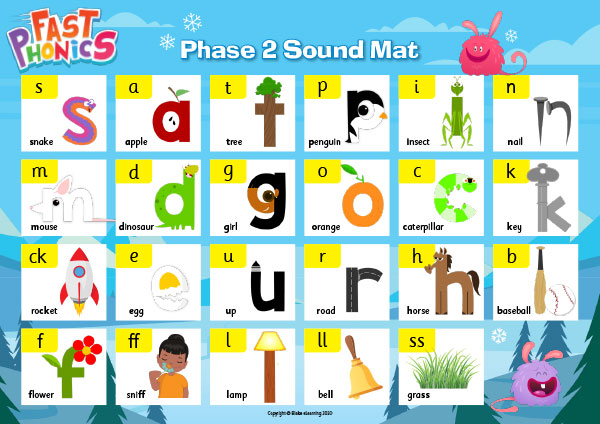
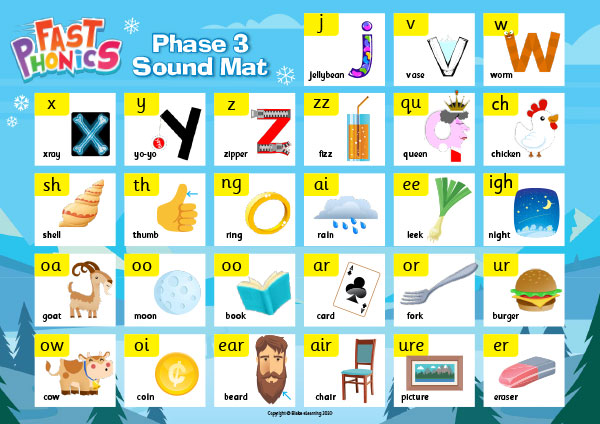
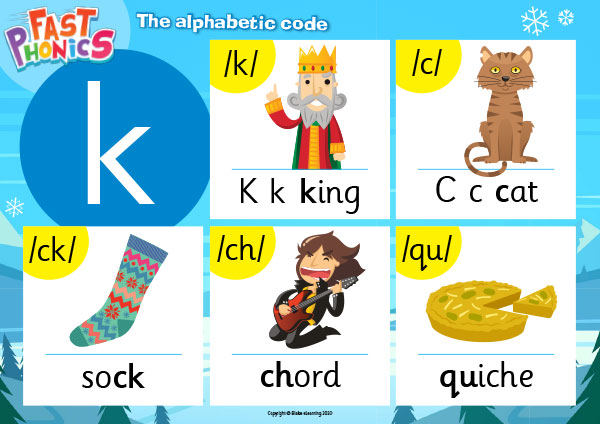
Academic research and government policy agree about the effectiveness of synthetic phonics instruction (Hempenstall, 2016). Synthetic phonics teaches letter–sound relationships in an explicit and systematic sequence. This ‘first and fast’ approach to reading instruction introduces children to individual phonemes and letter sounds, so that they can rapidly decode words and read independently.
Synthetic phonics instruction is grounded in research. Most notably, a longitudinal research project in Clackmannanshire, Scotland, linked synthetic phonics instruction to remarkable gains in students’ reading abilities. The Clackmannanshire studies were seminal to establishing the pre-eminence of synthetic phonics instruction for emergent and early readers (see Appendix A for details).
Following the Clackmannanshire studies, the UK Government tasked Sir Jim Rose, then Her Majesty’s Chief Inspector of Primary Education, with conducting the Independent review of the teaching of early reading. The review examined the most effective method of systematic phonics instruction. The resultant ‘Rose Report’ concluded that ‘the case for systematic phonic work is overwhelming and much strengthened by a synthetic approach’ (Rose, 2006:20).
In Australia, the National Inquiry into Teaching Literacy in Australia recommended teachers provide systematic, direct and explicit phonics instruction to ensure that children master the essential alphabetic codebreaking skills required for foundational reading proficiency (Rowe, 2005).
Research also found that systematic synthetic phonics had substantial advantages over analytic phonics for the reading and spelling skills of students in their second year of school (Christensen and Bowey, 2005). Research on high performing elementary schools in Western Australia found that all of the schools used synthetic phonics programs in the early years (Louden, 2015; See Appendix B for details about the use of synthetic phonics in Australia).
In the United States, the National Reading Panel found that systematic phonics programs produce greater growth in reading than other reading programs, and that synthetic phonics instruction is especially effective for younger, at-risk readers (National Reading Panel, 2000). In addition, a largescale study conducted by Barbara Foorman at the University of Houston found that systematic synthetic phonics was by far the most effective reading instructional method (Hempenstall, 2016 quoting Foorman et al., 1997).
Large numbers of children in Australia are not meeting the expected learning outcomes and standards in literacy (Expert Advisory Panel, 2017). Effective reading instruction, specifically synthetic phonics instruction, in the early years of schooling is critical to improving students’ literacy.
Phonics instruction is included in the Phonics and Word Knowledge substrand of the Australian Curriculum F-10 English curriculum (ACARA). State education departments, including New South Wales, South Australia and Western Australia, are increasingly encouraging the use of synthetic phonics in the classroom. Indeed, the NSW Centre for Education Statistics and Evaluation advised that synthetic phonics programs are ‘the most effective method of teaching phonics’ (NSW Centre for Education Statistics and Evaluation, 2017:8).
There have also been calls to adopt a nationwide phonics check for Grade 1 students (Expert Advisory Panel, 2017; Snow, Castles, Wheldall and Coltheart, 2016). In 2019, the Australian Government announced that it will introduce a free, voluntary phonics check for Grade 1 students (Media release: ‘Bringing phonics into Australian schools’, Minister for Education, 2019). Certain states have already acted; following a trial of a phonics check in 2017, South Australia introduced a mandatory phonics check for all Grade 1 students in public schools in 2018. New South Wales is trialling a similar check in 2020.
The Australian Government has also committed funds to the Australian Institute for Teaching and School Leadership to provide expert advice on incorporating phonics into the national accreditation standards for initial teacher education (Media release: ‘Bringing phonics into Australian schools’, Minister for Education, 2019).
Fast Phonics uses the power of synthetic phonics to boost reading skills. The program is a phonics ‘first and fast’ approach that uses high-quality systematic, synthetic phonics instruction as the principle approach to decoding print. The program is designed for emergent and early readers (Foundation-Grade 2), as well as older students with gaps in their core reading knowledge.
Fast Phonics is closely aligned to the United Kingdom’s Letters and Sounds program. It includes 20 ‘peaks’ that cover a set of letters and sounds. The program ensures that children progress from simple to more complex phonics knowledge and skills and that they cover the major grapheme/ phoneme correspondences. Fast Phonics has been specifically designed to be used in discrete, daily classroom practice. It recognizes that children learn in different ways and uses a multisensory approach to engage students with visual, auditory and kinaesthetic activities. With a range of videos, interactives, activities and decodable books, Fast Phonics explicitly and systematically teaches, supports, reinforces and assesses the core phonics skills, namely:
Fast Phonics also covers pseudo-words. Pseudo-words are strings of letters that resemble real words. These types of words are included in phonics checks.
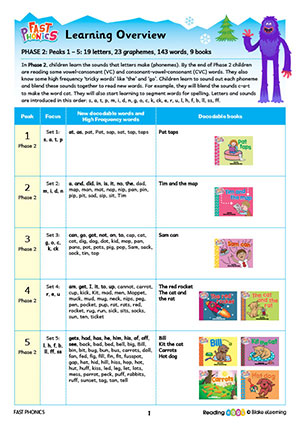
It is well established that phonics is one of five essential elements that students must master to become fluent readers. The other elements are phonemic awareness, vocabulary, comprehension and fluency (National Reading Panel, 2000). This paper focuses on the systematic synthetic phonics instruction provided by the Fast Phonics program; for detail about how Fast Phonics builds learners’ phonemic awareness, vocabulary, comprehension and fluency skills, see Appendix C.
Letter–sound correspondence is the foundation of phonics instruction. Children’s knowledge of letter names and sounds is the best predictor of future reading and spelling ability (Piasta and Wager, 2010 quoting Hammill, 2004; Scarborough, 1998; Schatschneider, et al., 2004).
Fast Phonics teaches children to identify letter–sound correspondence in short, snappy sessions. Each peak uses animations to explain either a reading strategy or introduce a letter, phoneme, digraph, trigraph or split digraph.
Next, students commence activities that reinforce their new knowledge. For example, in Flying Furballs children identify which of the three Furballs makes the phoneme that corresponds with the onscreen grapheme. Four Square also explicitly teaches letter–sound correspondence. Students hear a phoneme at the beginning of the activity and must tap the square that includes the grapheme that the phoneme represents.
Similarly, in Snowballs, students match the marked snowball to the letter that appears at the top of the screen. Children tap on the letter to hear the sound that it makes.
Mountain Climb teaches students how to identify sounds at the beginning, middle and end of a word. Children help Yeti climb a mountain by identifying the missing sound in a word. For example, the word ‘might’ is pronounced and appears on screen with a missing sound, such as ‘m____t’. The child is given four possible solutions for the missing sound, including /p/, /ee/, /k/ and /igh/. When a learner successfully identifies the missing sound, Yeti climbs to the next step, where a similar question will be posed.
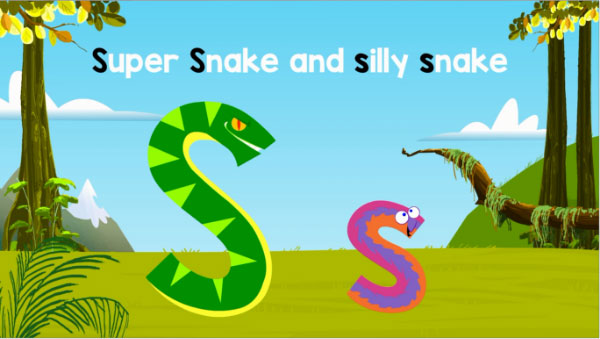
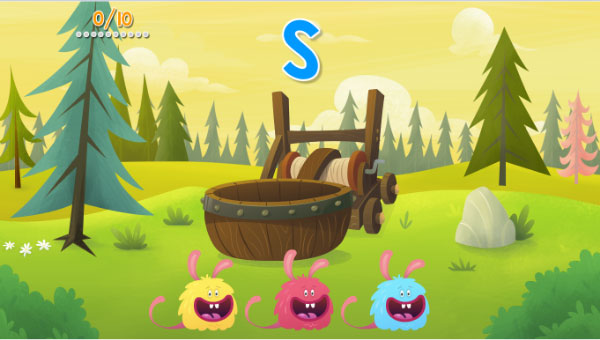
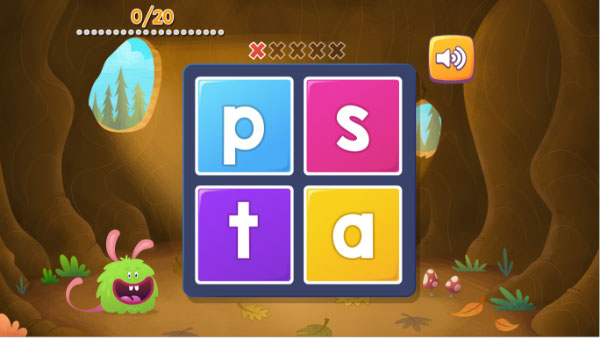

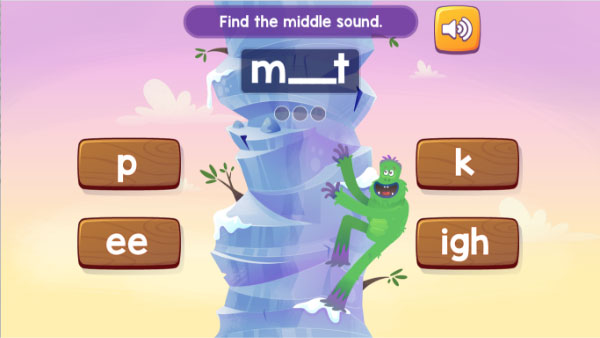
Blending is a key synthetic phonics skill. Unlike other types of phonics instruction, synthetic phonics teaches beginning readers to blend or ‘synthesise’ phonemes right from the outset, in order to develop word reading skills (Johnston and Watson, 2007).
Fast Phonics teaches students to blend phonemes in order, from left to right, ‘all through the word’ for reading. In the program students are taught to identify and blend sounds to decode words with consonant– vowel–consonant patterns, before moving on to more difficult words. For example, the six animations and 13 activities in Peak 1 quickly and explicitly introduce the sounds /s/, /a/, /t/ and /p/. In Peak 1, Stretch It Out teaches students to identify individual phonemes and then to blend all the way through the word to decode tap, sat, pat and sap.
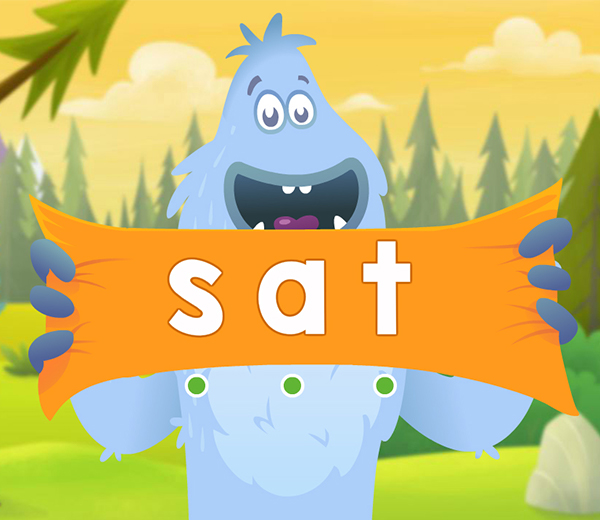
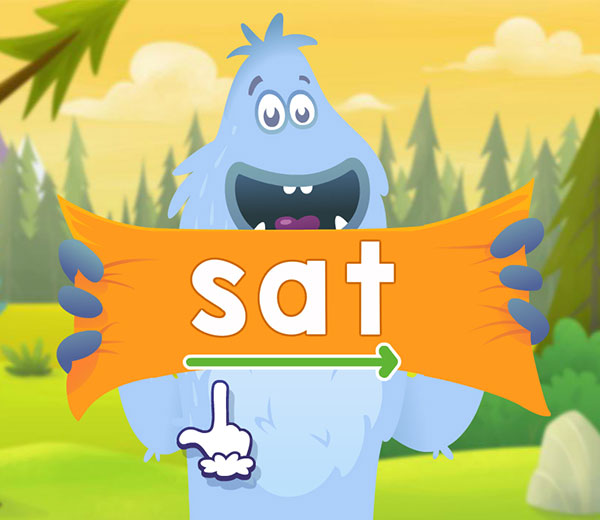
Stretch It Out is one of many Fast Phonics activities that teaches blending skills. Students identify individual sounds and then learn how to blend through a word.
Synthetic phonics teaches children to simultaneously spell words by segmenting them into phonemes while teaching blending to decode. Moreover, they learn that segmenting is the reverse of blending (Glazzard, 2017).
Fast Phonics animations and activities teach students how to spell words by segmenting them into their constituent phonemes. For example, in Block the Road students assemble phoneme blocks to make the correct word and help Yeti catch the Furballs.
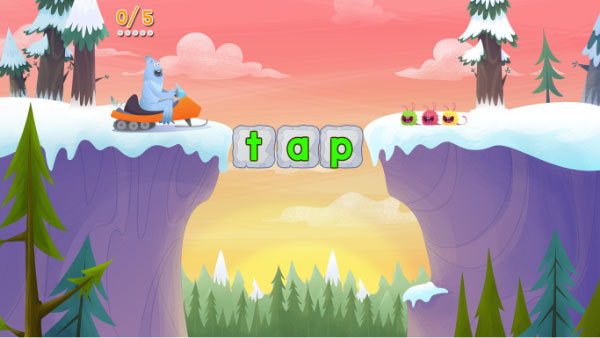
Block the Road is used in Peak 1 and Peak 3 to develop students’ segmenting skills. The activity also features in Peaks 4, 8 and 9 with increasing difficulty.
Students learn spelling skills in Send a Message. In this activity children type a dictated message to Yeti using recently learned words. For example, in Peak 6 students are asked to type the message ‘Ten bad rats got the big sack’. When shown two images, children match the image to the message to demonstrate that they comprehend what they have written.
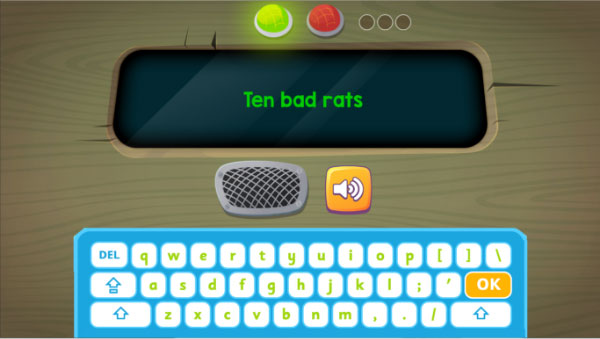
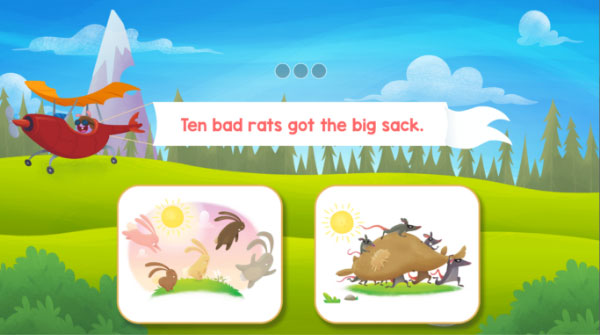
Send a Message hones students’ spelling skills.
Full Circle teaches children to spell various words using letter tiles. For example, in Peak 2 students use /m/, /a/, /p/, /t/ and /s/ to spell map, mat, sat, sit, pip, sip and sap.
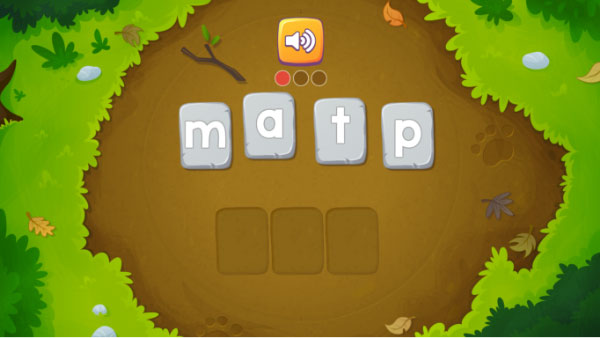
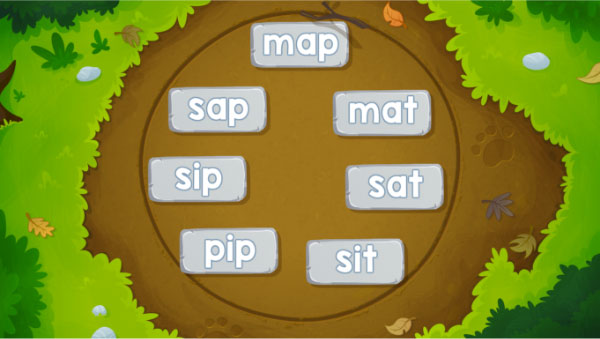
Research indicates that the more attuned a child is to the phonological structure of words, such as syllables and phonemes, the more successful a decoder and reader he or she will become (Ritter, Park, Saxon and Colson, 2013 quoting Lewis et al., 2006; Otaiba, Puranik, Ziolkowski and Montgomery, 2009). Consequently, it is important to teach learners how to identify and manipulate syllables.
Fast Phonics includes syllable manipulation animations and activities from Peak 4 onwards. The Silly Bulls activity begins by introducing a new word, such as ‘rabbit’. As most syllables contain a vowel (particularly in short words), the activity initially helps students identify the vowels in a word. It then explains that words can be broken up into syllables. To demonstrate this visually, the animation splits the word. Children read the syllables individually and then blend them together. They are then shown two images and must match the image to the word to demonstrate that the word has been read correctly.

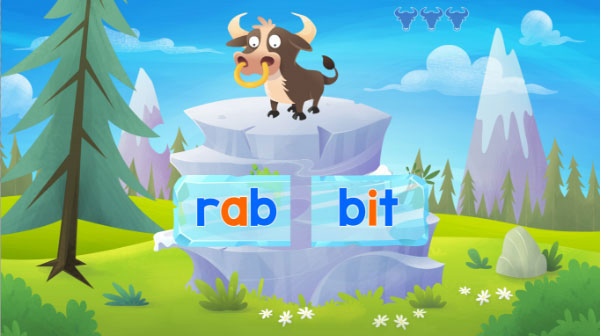
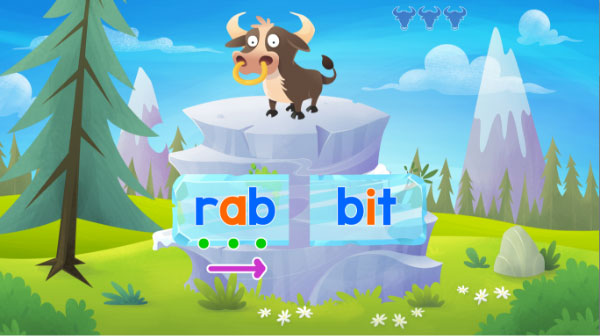

Silly Bulls teaches syllable manipulation and blending through the word.
As discussed, the initial focus of synthetic phonics programs is to teach children to identify, blend and segment phonemes. Consequently, it is considered appropriate to practise these skills on pseudo-words. The ability to decode real and pseudo-words is the basis of the phonics screening check used in England.
Furball Fun asks whether a word that appears on screen is real, such as ‘town’, or not, like ‘pas’. Once students make a selection, the individual sounds in the word are separately enunciated.
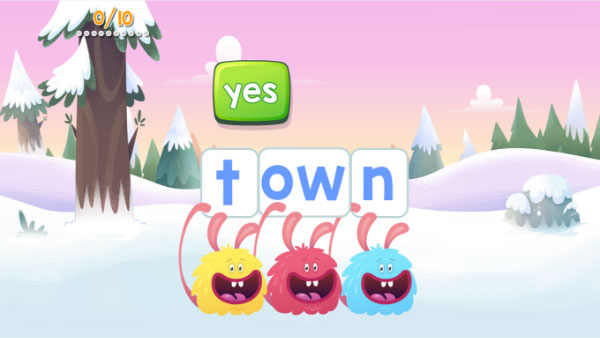
Furballs cheer on students who correctly identify words and pseudo-words in Furball Fun.
Synthetic phonics uses decodable books to ‘cement’ new knowledge (Konza, 2011). Each Fast Phonics peak includes up to four decodable books and an accompanying end-of-book quiz. Students enjoy using the books to practise their new decoding skills. Additionally, being able to read books gives learners confidence, which is critical in the earliest stages of learning to read. Feeling successful helps motivate learners to practise. These components work together to hone phonics skills, as research demonstrates these are key for literacy success. Furthermore, the endof-book quizzes are an opportunity to reinforce and assess students’ decoding skills.

Fast Phonics includes a range of decodable books that reinforce students’ knowledge. The end-of-book quizzes assess their knowledge and provide insightful data to inform your classroom practice.
Assessment and reporting are embedded in Fast Phonics. The program assesses letter-sound correspondence; letter recognition; the ability to sound out phonemes; the ability to hear and blend phonemes; the reading of phonically regular words; and the reading of some irregular words.
Fast Phonics commences with a placement test. This test personalizes a student’s program by identifying strengths and areas for improvement. It also ensures he or she begins on the most appropriate peak.
Each peak concludes with a narrated 10-question multiple choice quiz that reinforces and assesses phonics skills. Students immediately move to the next peak if they receive 80% or more on the quiz. Students who are unsuccessful can re-take the assessment.
Additionally, each decodable book includes an end-of book quiz that assesses students’ comprehension. There are up to four decodable books in each peak.
Children can monitor their own progress in the My Progress area. For example, students can view their average score for end-of-peak quizzes, as well as the total number of sounds and words learnt, and books read.
Teachers can monitor students’ progress via the Teacher Dashboard, where they can see what letters and sounds their students know and which decodable books they have read.
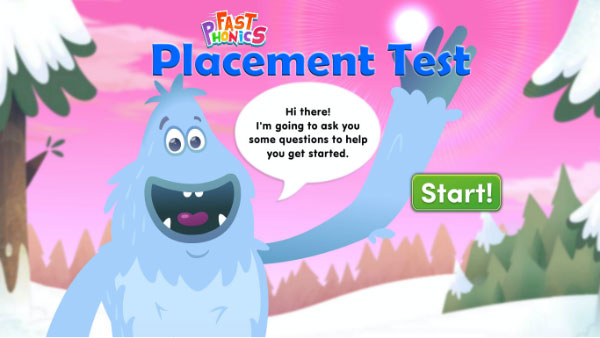
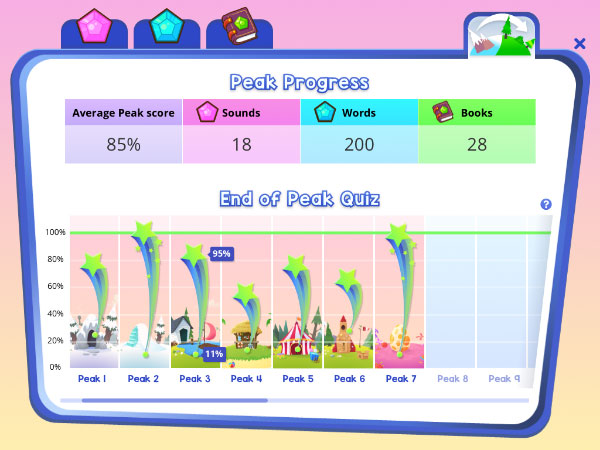
Motivation is the key to learning any new skill, and reading is no exception. It is crucial for reading instruction to encourage students’ reading motivation and engagement (Wigfield, Gladstone and Turci, 2016). In large part, this is because motivation is a predictor of reading comprehension growth (Guthrie et al., 2007; Taboada, Tonks, Wigfield and Guthrie, 2009). Reading motivation is multidimensional; self-efficacy and intrinsic (internal) and external motivation are the three most important factors.
Self-efficacy refers to a child’s belief in their ability to complete a task. It is based on a child’s previous experience and the encouragement and feedback they receive from others (Wigfield, Guthrie, Tonks and Perencevich, 2004). Successfully completing a task provides a child with the confidence to undertake a similar activity. For example, reading a decodable book provides a child with the confidence to attempt a second book. Confidence is vital to academic success. Indeed, believing in oneself is more closely linked to achievement than any other motivation throughout school (Guthrie, 2013).
Fast Phonics fosters self-efficacy in emergent and early readers. The program is specifically sequenced to build students’ knowledge and confidence. Synthetic phonics instruction, such as that offered in Fast Phonics, quickly and deliberately teaches how to identify letter–sound correspondence and how to blend and segment sounds. The program maintains its fidelity to synthetic phonics instruction as children progress to high-frequency words that do not conform completely to letter–sound correspondence rules. This structure gives students the confidence to continue through the program.
Intrinsic motivation refers to a child’s desire to complete a task for their own sake, such as reading out of curiosity or the desire to be challenged (Wigfield and Guthrie, 1997). External motivations are benefits that children receive for their efforts, such as rewards. While children respond positively to external rewards when learning to read, the key to ongoing reading success is intrinsic motivation (Cambria and Guthrie, 2010).
Fast Phonics understands this delicate balance and uses a range of external rewards to encourage students while simultaneously supporting the development of intrinsic motivations. For example, the playful characters, Yeti Coins, exciting upgrades and interactive rewards in Fast Phonics engage and motivate students to keep learning. At the same time, the program’s planned sequence of activities quickly builds and consolidates reading skills and confidence to ensure children move from decoders to master readers.
Peaks include carefully sequenced animations and activities to quickly introduce the concept of letter–sound correspondence, blending and segmenting. Consequently, students can independently read decodable books by the end of Peak 1.

Yeti and the Furballs encourage students to progress through Fast Phonics.

Gems and Yeti Coins motivate students to complete Fast Phonics activities.
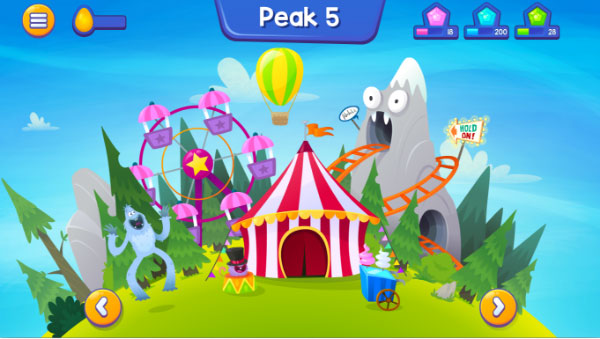
Fun upgrades encourage students to stay on task.
Digital technology has transformed teaching and learning in classrooms across the globe. There are significant benefits to incorporating technology into reading instruction, including increasing student motivation and personalizing programs to allow learners to learn at their own pace (Jamshidifarsani, Garbaya, Lim and Blazevic, 2019).
Experimental and quasi-experimental studies have shown that information and communication technologies use can positively affect children’s literacy (Piquette, Savage and Abrami, 2014; Cheung and Slavin, 2012).

Information and communication technologies use can positively affect children’s literacy.
For example, a study of kindergarten children in the United States (equivalent to kindergarten students in Australia) found that computer assisted instruction to teach phonics, in addition to regular in-class teaching, can enhance students’ reading skills, particularly for at-risk children (Macaruso and Walker, 2008). Similarly, a quasi-experimental study in Australia found that using a computer-based phonics program improved students’ phonological awareness compared to regular literacy instruction (Wolgemuth et al., 2011).
Blended learning – combining digital and pen-and-paper activities and using data to provide a personalized education plan – is beneficial to developing phonological awareness, word attack (letter–sound knowledge), word identification skills and reading fluency (Prescott, Bundschuh, Kazakoff and Macaruso, 2017). Research conducted in the United States demonstrated that elementary school students, including children from low-SES backgrounds and English Language Learners who use a blended learning program make ‘great progress’ in English Language Arts and demonstrate ‘significant growth on a standardized reading test’ (Prescott, Bundschuh, Kazakoff and Macaruso, 2017:505).
A useful schema for discussing the potential impacts of various reading technologies is the QAIT model of effective classroom practice (Slavin, 1994, 2009). This framework posits that effective teaching is a product of four factors:
Fast Phonics meets these criteria. The program has a clear, consistent lesson structure that is rigorously mapped to learning outcomes and uses best practice education research to teach, support, reinforce and assess student knowledge. The extensive rewards and other motivational tools, such as upgrades and animations, encourage children to complete all activities and, ultimately, to complete the program as proficient readers.
The careful sequence of Fast Phonics peaks builds students’ confidence as readers, helping them move from basic letter–sound correspondence to more advanced reading skills, including automaticity, fluency and comprehension. As a synthetic phonics program, Fast Phonics deftly introduces concepts to students’ existing decoding skills. Students’ progress through the program at their own pace, and the interactive reading, spelling and comprehension activities are opportunities to practise and reinforce their skills.
Teacher quality is critical to ensuring that students use online reading programs successfully (Duncan-Owens, 2009). The Fast Phonics Teaching Guide provides clear and detailed information to help teachers use the program effectively. Teachers can also quickly and easily access students’ end-of-peak assessment results in the Teacher Dashboard to monitor students’ progress and inform classroom practice.
Research demonstrates that synthetic phonics instruction provides a strong foundation for reading skill and reading confidence in learners. Being able to efficiently decode new words gives learners the confidence to read more, setting them on a more successful school trajectory.
Fast Phonics is a rigorous synthetic phonics program built on best practice research. The sequential program of 20 peaks introduces letter–sound correspondence systematically. By explicitly teaching segmenting and blending sounds early, Fast Phonics enables learners to make connections between letters, sounds and pronunciation to develop a strong alphabetic principle.
Each peak thoroughly covers one set of letter–sound correspondence using highly motivating and engaging animations, activities, interactives, books and quizzes. The teaching animations and strategy animations teach and reinforce systematic synthetic phonics. The multisensory interactive activities allow children to practise key phonics skills, including letter–sound recognition, blending all through the word, segmenting and spelling, pseudo-words, syllables, reading captions and extended text. The decodable books and end-of-book quizzes allow children to use and reinforce their reading skills. The end-of-peak quizzes are an opportunity to assess students’ abilities and monitor their progress. Fast Phonics also has a bank of printable resources, including a teaching guide and printable student worksheets to assist classroom practice.
Fast Phonics is rigorous but fun. This complete synthetic phonics program is a dynamic mix of maps, upgrades and exciting learning activities where children can learn, laugh and see what’s next.
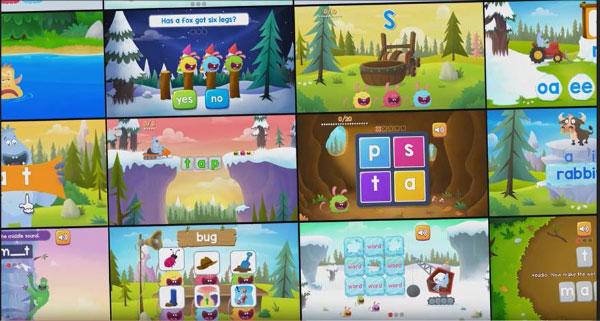
Fast Phonics the systematic, synthetic phonics program where children can learn, laugh and see what’s next.